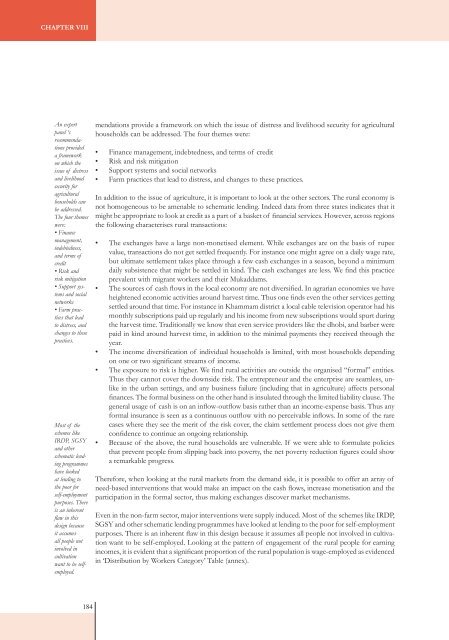SOIL Report 2008 - ACCESS Development Services
SOIL Report 2008 - ACCESS Development Services
SOIL Report 2008 - ACCESS Development Services
Create successful ePaper yourself
Turn your PDF publications into a flip-book with our unique Google optimized e-Paper software.
Chapter VIIIAn expertpanel ‘srecommendationsprovideda frameworkon which theissue of distressand livelihoodsecurity foragriculturalhouseholds canbe addressed.The four themeswere:• Financemanagement,indebtedness,and terms ofcredit• Risk andrisk mitigation• Support systemsand socialnetworks• Farm practicesthat leadto distress, andchanges to thesepractices.Most of theschemes likeIRDP, SGSYand otherschematic lendingprogrammeshave lookedat lending tothe poor forself-employmentpurposes. Thereis an inherentflaw in thisdesign becauseit assumesall people notinvolved incultivationwant to be selfemployed.mendations provide a framework on which the issue of distress and livelihood security for agriculturalhouseholds can be addressed. The four themes were:• Finance management, indebtedness, and terms of credit• Risk and risk mitigation• Support systems and social networks• Farm practices that lead to distress, and changes to these practices.In addition to the issue of agriculture, it is important to look at the other sectors. The rural economy isnot homogeneous to be amenable to schematic lending. Indeed data from three states indicates that itmight be appropriate to look at credit as a part of a basket of financial services. However, across regionsthe following characterises rural transactions:• The exchanges have a large non-monetised element. While exchanges are on the basis of rupeevalue, transactions do not get settled frequently. For instance one might agree on a daily wage rate,but ultimate settlement takes place through a few cash exchanges in a season, beyond a minimumdaily subsistence that might be settled in kind. The cash exchanges are less. We find this practiceprevalent with migrant workers and their Mukaddams.• The sources of cash flows in the local economy are not diversified. In agrarian economies we haveheightened economic activities around harvest time. Thus one finds even the other services gettingsettled around that time. For instance in Khammam district a local cable television operator had hismonthly subscriptions paid up regularly and his income from new subscriptions would spurt duringthe harvest time. Traditionally we know that even service providers like the dhobi, and barber werepaid in kind around harvest time, in addition to the minimal payments they received through theyear.• The income diversification of individual households is limited, with most households dependingon one or two significant streams of income.• The exposure to risk is higher. We find rural activities are outside the organised “formal” entities.Thus they cannot cover the downside risk. The entrepreneur and the enterprise are seamless, unlikein the urban settings, and any business failure (including that in agriculture) affects personalfinances. The formal business on the other hand is insulated through the limited liability clause. Thegeneral usage of cash is on an inflow-outflow basis rather than an income-expense basis. Thus anyformal insurance is seen as a continuous outflow with no perceivable inflows. In some of the rarecases where they see the merit of the risk cover, the claim settlement process does not give themconfidence to continue an ongoing relationship.• Because of the above, the rural households are vulnerable. If we were able to formulate policiesthat prevent people from slipping back into poverty, the net poverty reduction figures could showa remarkable progress.Therefore, when looking at the rural markets from the demand side, it is possible to offer an array ofneed-based interventions that would make an impact on the cash flows, increase monetisation and theparticipation in the formal sector, thus making exchanges discover market mechanisms.Even in the non-farm sector, major interventions were supply induced. Most of the schemes like IRDP,SGSY and other schematic lending programmes have looked at lending to the poor for self-employmentpurposes. There is an inherent flaw in this design because it assumes all people not involved in cultivationwant to be self-employed. Looking at the pattern of engagement of the rural people for earningincomes, it is evident that a significant proportion of the rural population is wage-employed as evidencedin ‘Distribution by Workers Category’ Table (annex).184














